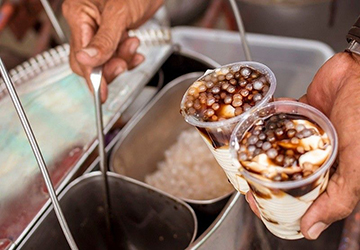Southeast Asia offers an extensive culinary landscape with its rich tapestry of cultures, traditions, and history. Diving into its street food culture is one of the best ways to experience this vibrant region. From roadside stalls to bustling food market delicacies, the streets are alive with flavors waiting to be explored.
The essence of Southeast Asian snacks goes beyond mere sustenance. They narrate stories of their origin, a blend of local ingredients, traditional cooking methods, and generations of culinary wisdom. In Thailand, for instance, the sight of freshly made 'Mango Sticky Rice' or 'Moo Ping' (grilled pork skewers) can transport you to the age-old street corners of Bangkok. Meanwhile, Vietnam offers the comforting 'Banh Mi,' a fusion of French and Vietnamese tastes, in a crispy baguette sandwich.

Southeast Asia's street food culture mirrors its society - dynamic, colorful, and inclusive. These streets are places of community gatherings, where food is a universal language connecting different ethnicities and backgrounds. Be it the bustling streets of Manila, where you can savor 'Isaw' (grilled chicken intestines), or the serene lanes of Bali, where 'Lawar' (a traditional mix containing fine chopped coconut, garlic, and chili) reigns supreme; the culture is unparalleled.
One thing that Southeast Asian market street food has in abundance is fermented products. This is the unique characteristic of Asian street foods. Following are products products that undergo fermentation and are widely used in street food:
● Indonesia's Tempeh: A testament to the power of fermentation, this soy product is nutty in flavor and packed with nutrition.
● Thailand's Som Tam: This spicy papaya salad occasionally uses fermented crab, bringing an umami punch to each bite.
The heart of Southeast Asian culinary treasures often beats loudest in its markets. These hubs of food market delicacies offer a variety from sweet treats to spicy concoctions. In Malaysia, 'Pasembur,' a Penang salad with crispy treats and a sweet-spicy peanut sauce, is a must-try. Alternatively, Laos presents 'Khao Piak Sen,' a comforting noodle soup perfect for any time of the day.
Regional bites from various Southeast Asian countries provide insights into locals' specific tastes and preferences. For instance, while Indonesia boasts its spicy 'Sate Padang' (a meat skewer), Cambodia serves its unique 'Nom Banh Chok' (Khmer noodles with green fish curry).
Singapore, a melting pot of cultures, gives us 'Hainanese Chicken Rice,' a simple yet flavorful dish, while Myanmar tempts us with 'Mohinga,' a fish soup noodle considered its national dish. Each bite of these regional bites showcases the diversity and complexity of the region's flavors.
Whether you're an early riser or a night owl, Southeast Asia's food streets cater to every schedule:
Morning Delights: Begin with the Philippines' 'Taho,' a warm silken tofu dessert, or Vietnam's 'Pho,' a hearty noodle soup.
Afternoon Indulgences: Relish on Indonesia's 'Gado-Gado,' a mixed vegetable salad with peanut sauce, or Thailand's 'Pad Thai.'
Night-time Cravings: End the day with Malaysia's 'Nasi Lemak,' rice cooked in coconut milk, or Singapore's 'Chilli Crab.'
Every ingredient used in Southeast Asian snacks has a story:
Lemongrass: Predominantly used in Thai and Vietnamese cuisines, this herb adds a citrusy zest, transporting one straight to the lemongrass farms of the region.
Tamarind: Essential in many regional bites, it brings a tangy undertone to dishes, reminiscent of the large tamarind trees dotting the Southeast Asian landscape.
While traditions run deep, innovation is at the heart of street food culture:
Thai-Indian Fusion: In Thailand, 'Roti' has been transformed. Originally a flatbread from India, it's now a sweet or savory treat filled with everything from bananas to curry.
Vietnamese Coffee: A twist to regular coffee with condensed milk, capturing the essence of French influence and local preferences.

Navigating Southeast Asia's streets is about more than savory delights. Dive into a world of sugary masterpieces, from Thailand's 'Khanom Chan' (layered dessert) to Indonesia's 'Klepon' (sweet rice cake balls). These desserts, often wrapped in colorful packages, are a testament to the region's love for sweet endings and traditional confections.
In the heart of Southeast Asia, streets are more than just pathways; they are culinary theaters:
Mobile Kitchens: Most street food vendors operate out of mobile setups, transforming pavements into gourmet corners within minutes.
Economic Impact: Beyond being just about food, these vendors play a significant role in the urban economy. It's a livelihood for millions, where family recipes are brought to life daily.
Social Dynamics: Dining on the streets is not a solitary affair. For many, it's a daily ritual where strangers bond over shared tables and delectable meals.
Street food in Southeast Asia appeals to all senses:
Visuals: The vibrant colors of fresh ingredients, the dance of flames, and the swift hands of vendors are a treat to the eyes.
Sounds The sizzles, the chatters, the clangs of pans; it's a symphony of sounds that narrates the life of the streets.
Smell: Even before you take that first bite, the aromas pull you in, promising an experience like no other.
Southeast Asia is a haven for food enthusiasts with its vast array of street food culture and regional bites. The tantalizing Southeast Asian snacks and the exquisite food market delicacies beckon travelers worldwide. With each bite, you taste the intricate flavors and immerse yourself in this vibrant region's rich history and tradition.
So, the next time you find yourself in Southeast Asia, let the streets guide your palate. Dive deep, savor each bite, and let the flavors narrate tales of regions, traditions, and people. After all, in the lanes of Southeast Asia, every morsel has a story to tell.